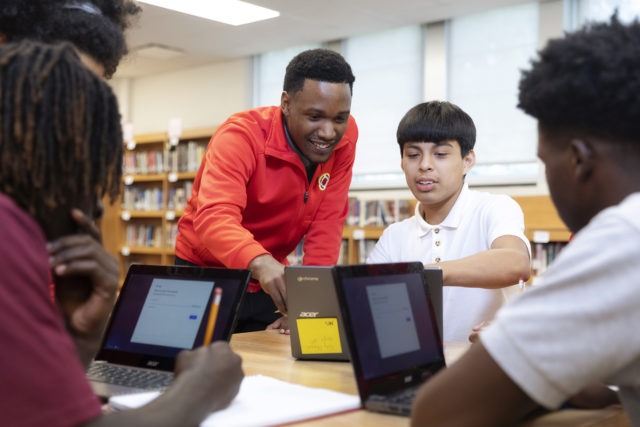Elevating student voice through the HSA
City Year’s holistic approach
Honoring, engaging and elevating student voice is central to City Year’s whole child work in schools. Powered by a belief in the power of young people—both our remarkable AmeriCorps members and the students they serve every day—City Year’s holistic approach to student success is grounded in the power of positive, consistent and caring relationships.
Serving full-time in public schools City Year AmeriCorps support students during their daily interactions with them in hallways, on playgrounds and in cafeterias, as well as during class time. As near-peer mentors, tutors and role models—old enough to offer guidance, young enough to relate to students’ perspectives—corps members are uniquely positioned to nurture developmental relationships with students. By taking time to listen to students during one-on-one mentoring conversations, in small group tutoring sessions or while planning fun school-wide events designed to reinforce academic goals and enhance school culture and climate, AmeriCorps members nurture a sense of trust and belonging in students while ensuring that student perspectives are heard and incorporated into adult decision-making in schools.
Learn more about the importance of developmental relationships in City Year’s Whole School, Whole Child services and how they support student success.
In recent years, as part of its broader set of youth development tools, City Year has begun using a student self-reporting measure, the Holistic Student Assessment (HSA). The assessment offers a way to elevate and engage student perspectives on their learning environment and to identify, leverage and build upon each student’s strengths.
Developed by the PEAR Institute, the HSA is an online survey that provides data on student perspectives from the students themselves. The HSA brings much-needed student voice into the identification of students’ own strengths, challenges and degree of school engagement. When added to other important data—including attendance, grades and teacher input, a clearer picture of student needs and assets emerge.

Our work in Columbus, Ohio
Over the past three years, City Year has piloted the HSA in several sites, including Columbus, Ohio. Students in Columbus have reported a statistically significant positive change their own learning interest, critical thinking, perseverance and academic motivation from the start-of-year to the end-of-year.
“The HSA data helps us change and tailor our approach to fit the continued evolution of our students,” says Kirsten Davis, a City Year Columbus Impact Manager who works closely with a team of AmeriCorps members, including coaching them on how to review data. “As students grow and change, we continue to grow and change.”
We are learning more about student perspectives on learning through this information and experience. In the 2019-2020 school year, City Year is expanding the pilot to schools in seven more cities where City Year serves, with plans to extend to all 29 sites over the next few years.
The holistic student assessment
The HSA is a data tool designed to both promote social-emotional development in students in school and afterschool settings and tap into student perceptions, preferences and mindsets, ensuring their voice is heard and that students feel a sense of agency about their learning experience. Students in grades three through nine respond to 61 questions (approximately 30 minutes in length) that relate to PEAR’s Clover model, a youth development framework that City Year uses throughout its network as part of its broader youth development and student support services.
The survey results provide a portrait of each student’s unique strengths and challenges in different social-emotional areas, such as learning interest, critical thinking, academic motivation and school bonding, among others.
Over the last three years, City Year has shared data from the HSA with their partner schools and hopes to eventually use this information to help City Year AmeriCorps members, classroom teachers and principals differentiate teaching approaches for students. The HSA, combined with the Clover framework, can help adults in schools to provide targeted intervention strategies for every student and accelerate school-wide improvement efforts.
In Columbus, City Year AmeriCorps members participate in regular data review cycles to track student progress in key social and emotional competencies. Corps members walk through individual student data as a team to better understand trends by grade, and self-identified markers such as gender and race. In the future, after naming trends, City Year teams aspire to work with school staff to discuss how they can work together to build on each student’s strengths, modify supports to meet student needs, and seek a more holistic approach to address trends.
Bridging the gap between adults and students
The HSA offers an opportunity for teachers, City Year AmeriCorps members and staff to better understand their students. Equipped with data that helps to bridge the gap between how students express themselves and how they feel, teachers can differentiate their instruction and apply support strategies to better enable student learning.
“I love the HSA because it allows us to see students more holistically,” said Kirsten Davis. “The HSA allows AmeriCorps members us to understand who students are in the moment and it helps them get to know students more deeply and see their complexity as learners and as people.”
While City Year already uses a robust suite of tools to assess and support students’ social-emotional development during their educational experience, the HSA offers unique insights because it provides students with a space to share their thoughts about their learning environment, their peers and the adults who support their learning. City Year AmeriCorps members can then review the HSA data to determine the social-emotional skills the students have self-identified as challenges and then work with their students during regularly scheduled check-ins. These personalized touch points allow corps members to customize approaches to student learning and help students to problem solve and set goals.
Read more about City Year’s holistic approach to student success.
Improving school culture and climate
In addition to providing information about individual and small groups of students, the HSA also shows data on how engaged the schools’ most struggling students are, and can provide principals, teachers and AmeriCorps members with valuable insight into the strengths and challenges of school culture and climate.
At one high school in Columbus, the City Year AmeriCorps members reviewed the HSA data and noticed that school bonding was very low. Students reported that they didn’t feel connected to school and they didn’t feel that school was a safe space for them.
After working with the principal to review the HSA data, the school decided to pilot strategies to increase student connections to school. A student leadership group formed to better understand what issues students are facing at school that adults may not be aware of. The school also began restorative justice circles to resolve conflicts—providing the space and time every other Friday for students to come together to participate in a student-led guided discussion to build relationships and strengthen the school community led by their peers. In addition, the school partnered with Kaleidoscope for Youth, a local organization that provides inclusivity LGBTQ training for students, so they can learn to work with others across differences.
By providing student and whole school portraits, the HSA data can be used as a catalyst for change to improve school culture and climate.
Expanding the HSA
Based on the encouraging outcomes of how the HSA can help to strengthen the connection among teachers, corps members and students, advance social-emotional development, and improve school culture and climate in seven Columbus schools, City Year has expanded the assessment to several additional cities this year—Detroit, Denver, Miami, New Hampshire, Sacramento, Seattle and Washington, D.C.—with plans to expand to every school across the City Year network. City Year will continue using the HSA to promote social-emotional development in school, inform youth development practices and, most importantly, elevate student voice and agency.
Contact us to learn more about supporting students inside and outside of school.
Related stories
Every year, thousands of young people decide to join AmeriCorps programs for a year (or more!) of service, helping to...
Read more about Everything you need to know about returning for another year as a City Year AmeriCorps memberCity Year is committed to providing our AmeriCorps members with resources, opportunities and support that help them to achieve their...
Read more about Empowering Futures: City Year Baton Rouge’s Partnership with Bottom LineFatimah Abdulmateen takes service seriously. Fatimah served two years with City Year as an AmeriCorps member, making her an alum...
Read more about A City Year alum with a passion for service—both here and abroadThough this part of the City Year experience may be particularly challenging, it’s also normal! And we want you to...
Read more about The “mid-fall slump” in schools is real--here's what to expect















